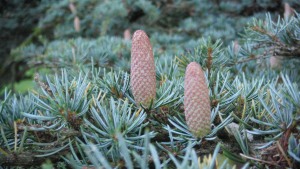Tree Facts – Cedrus at Compton Verney
Welcome to a page of the Compton Verney Landscape Garden blog, featuring a Fact Sheet for our Cedar of Lebanon trees.
Plant name: Cedrus libani (Pinaceae family)
Commonly known as: Cedar-of-Lebanon
Description:
An evergreen coniferous tree, with needle like leaves held on a network of branches generally known for their flat or tiered arrangement. Stems often arch down in an effort to touch the ground.
Information:
Many mature cedar trees in and around lawn areas, making Compton Verney a hot-spot in the Midlands for lovers of this particular tree – south Warwickshire to be precise (entry restrictions apply – please check website before visiting).
Most notable specimens include one placed centrally on each of the west and east lawns, dating most probably back to the eighteenth century landscaping by Lancelot ‘Capability’ Brown. The east (front) lawn specimen features lighter coloured foliage than usually found.
Another large Lebanon Cedar planted near to the lake on the west lawn could be the earliest introduced to site, reported as a county champion due to its impressive girth. This and others nearby received attention to relieve compaction to the root-zone, along with mulching.
Other cedar specimens were added throughout the grounds in each century after the eighteenth, including specimens of Cedrus deodara, which generally feature more upright stems.
Replanting of cedar trees at Compton Verney has been kept to a minimum to prevent over populating with this large growing specimen, however, three Cedrus atlantica were planted around ten years ago (now between 5 and 10 metres tall), and three young Lebanon Cedars have been planted more recently.
Fascinating Facts:
- The Cedar is an emblem of Lebanon, being displayed on the national flag and coat of arms. However, its prominence historically encouraged much felling, the timber being used in many situations from construction to religious ceremony – indeed it has many mentions in the bible.
- Cedar trees originate from south west Asia – yet whilst they have been plundered over many centuries, they have also been the focus of many conservation attempts. The Bsharre Cedar Grove in Lebanon being claimed and protected by the Emperor Hadrian, who carved stone markers around a vast area, then in 1876 when Queen Victoria funded the construction of a high wall around the 102-hectare grove.
- ‘Capability’ Brown used the tree often in planting schemes around the country. Considered an exotic, it would have been used aesthetically both for its young, generally conical form, and latterly for its ‘flattened’ and spreading branch network. It would have been used in both garden and parkland locations. Its biblical mentions, use through history and image of strength could also have been reason for its use in Brown’s schemes.
- A cedar in the ice house coppice at Compton Verney was chosen for a temporary interactive artwork by Hilary Jack titled Empty Nest. A human sized birds nest was installed for the latter half of 2013, allowing up to four people at a time to ascend steps to a large nest constructed from branches found around the grounds.
Sources:
Collins Tree Guide – Owen Johnson & David Moore
Wikipedia – Cedrus libani
Wikipedia – Cedars of God



